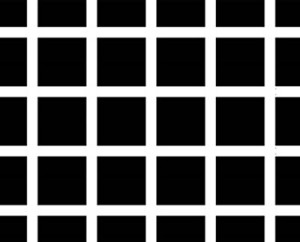The answer is what psychologists call Lateral Inhibition. 
The activity of one cell suppresses the activity of a nearby cell.
Lateral inhibition illustrates that vision is not a passive process of seeing merely what is objectively there; it also explains optical illusions.
Different photoreceptors in the eye respond to varying degrees of light.
When one cell activates in response to light, its activity impairs or prevents neighboring cells from activating. This causes the edges between light and dark areas to appear more prominent than they would be otherwise.
For example, without lateral inhibition, the border between a black tile and a while tile would appear less obvious.
This particular example is called Hermann’s illusion.




